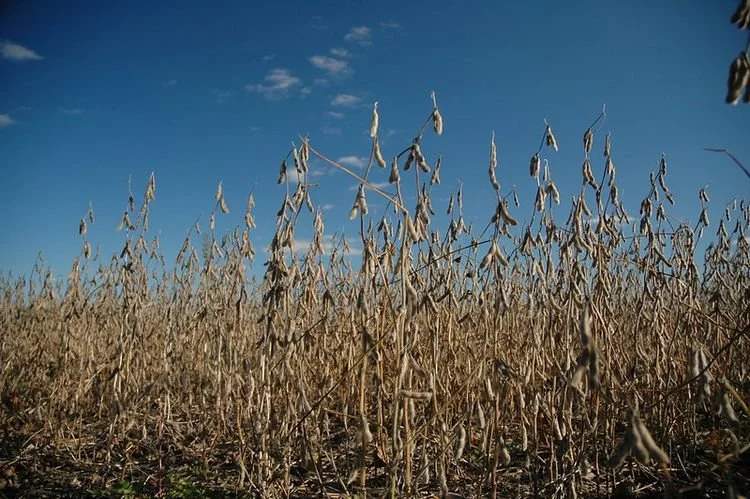For the first time since at least the 1990s, China hasn’t bought any U.S. soybeans at the start of the export season, a sign that Beijing is once again using agriculture as leverage in its trade fight with Washington.
Read MoreLouisiana has the most soybeans harvested, with the USDA reporting 63% completed. That’s 13 percentage points ahead of the prior week. At this time last year, 45% of soybeans were harvested. The five-year average is 47%.
The USDA reported that Louisiana soybean condition was rated 0% very poor, 0% poor, 20% fair, 78% good, and 2% excellent.
Read MoreCorn production is up, while soybean and cotton production is down from 2024, according to the Crop Production report issued by USDA’s National Agricultural Statistics Service (NASS). Corn production is up 13% from last year, forecast at 16.8 billion bushels; soybean growers are expected to decrease their production 2% from 2024, forecast at 4.30 billion bushels; cotton production is down 8% from 2024 at 13.2 million 480-pound bales.
Read MoreThis month’s 2025/26 U.S. corn outlook indicates greater supplies, larger exports, and a slight reduction in ending stocks. Projected beginning stocks for 2025/26 are 20 million bushels higher based on a lower use forecast for 2024/25, with reductions in imports and corn used for ethanol partially offset by an increase in exports. Corn production for 2025/26 is forecast at 16.8 billion bushels, up 72 million from last month as a 2.1-bushel reduction in yield to 186.7 bushels per acre is more than offset by a 1.3 million acre increase in harvested area to 90.0 million acres.
Read MoreThe USDA reported the most recent condition ratings for corn and soybeans earlier this week. There are clear “winners” — states with the highest rated crops — and “losers” — states with the lowest rated crops.
Read more about which states came out on top, and which are trending the wrong way just before harvest.
Read MoreThe U.S. soybean crop seems to be getting smaller. Drier weather has set in across much of the Midwest, which could taper soybean yields. Disease pressure is also starting to mount. But even with the potential for the soybean crop estimates to shrink, analysts warn without China coming to the table, soybean prices could be stuck in this low price pattern.
Read MoreThis report projects corn, soybeans, wheat, and rice futures prices for the United States for the third quarter (Q3) of 2025. Our analysis utilizes historical data on both cash prices (the price for immediate delivery) and futures prices (the price agreed upon for delivery at a future date).
We aggregate the daily futures prices into quarterly averages to simplify our analysis. Using this dataset, we train several machine learning models to predict futures prices for all four commodities.
Read MoreAn ag economist says the increased trade tensions between the U.S. and China are starting to negatively impact soybean prices.
Read MoreIn the USDA Crop Progress report released on Aug. 25, 12 states reported soybeans dropping leaves. Here’s a closer look at the 12 states that reported for that crop growth stage.
Read MoreThe American Soybean Association is urging President Trump to prioritize soybeans in U.S.-China trade talks, warning that retaliatory tariffs are shutting American farmers out of their largest export market going into the 2025 soybean harvest.
In a letter sent to the White House, the group called for the removal of Chinese tariffs on U.S. soybeans and commitments for future purchases. ASA also released a white paper outlining the financial consequences of losing long-term market share in China.
Read MoreThe U.S. Environmental Protection Agency (EPA) said it is extending the public comment period for proposed registration for three end-use dicamba products for broadleaf weed control in dicamba-tolerant cotton and dicamba-tolerant soybeans.
The comment period, originally set to expire on Aug. 22, has now been extended to Sept. 6, 2025.
Read MoreThis month’s 2025/26 U.S. corn outlook is for sharply higher supplies, greater domestic use and exports, and larger ending stocks. Projected beginning stocks for 2025/26 are 35 million bushels lower based on a slightly higher use forecast for 2024/25. For 2024/25, larger corn exports are partly offset by reductions in corn used for ethanol and glucose and dextrose. Corn production for 2025/26 is forecast at a record 16.7 billion bushels, up 1.0 billion from last month with a 1.9-million acre increase in harvested area and higher yield. If realized, this total would be 1.4 billion bushels more than the prior record set in 2023/24.
Read MoreBased on the most recent condition ratings for corn and soybeans reported by USDA, there are clear “winners,” or states with the highest rated crops, and “losers,” or states with the lowest rated crops.
Three top soybean-growing states reported that more than 80% of their crop was in good or excellent shape, but one of them dominated. USDA reported that 92% of Louisiana’s soybean crop was in good/excellent condition.
Read MoreAccording to USDA’s National Agricultural Statistics Service, as of last Sunday all of the Louisiana soybean crop was blooming, which is also the five year average for this time of year. 94-percent was setting pods, same for the five year average. That crop was rated 8 percent fair, 90 percent good and two percent excellent.
Read MoreAmid the business of summer, many farmers take a break from field chores to attend a field day. The opportunity to see firsthand the latest research that can help improve their profitability is a tradition that goes back to the 19th century and continues today.
Seaman A. Knapp planted the seed for Extension by pioneering the idea of demonstration agriculture. Considered the founder of Cooperative Extension, Knapp saw the power of teaching farmers modern, research-based techniques.
Read More













